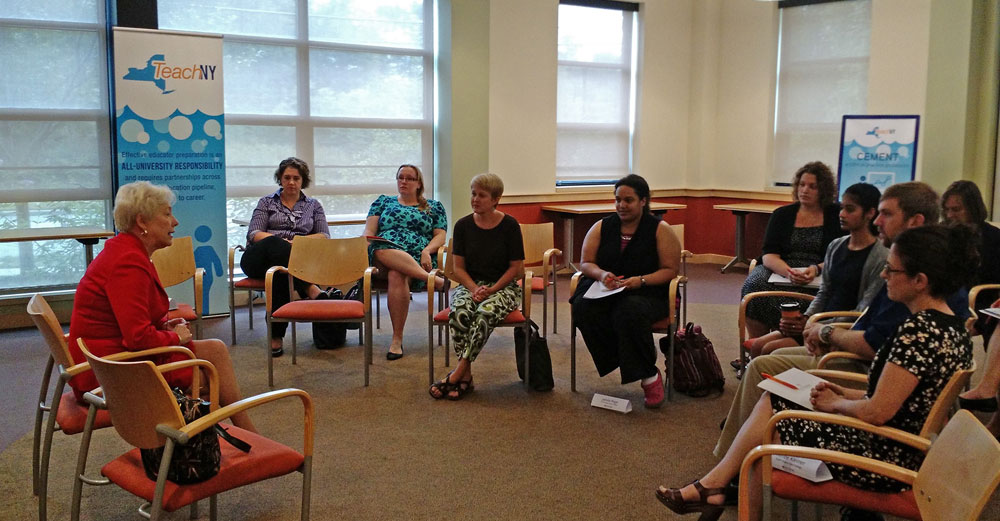
The news of the teaching industry in New York has been circulating for years now. Very soon, we are going to need more teachers to replace the retiring generation, and we will need them to be a revised model for the future of education. Studies show that we will need an average of 1,700 new teachers every year. Across the country, there will be a call for 1.6 million new teachers over the next decade. These reports are a key contributor behind the creation of the TeachNY initiative, a movement to lift up the teaching profession and to ensure that New York and the nation will have the high quality educators needed for the future.
Yesterday, at the SUNY Board of Trustees meeting in New York City, the research and hard work with teachers throughout New York State came to fruition as Chancellor Zimpher and the Academic Affairs Committee of the Board of Trustees approved the TeachNY policy that will guide SUNY to achieve a higher standard of excellence in educator preparation and support. This policy will be considered by the full Board of Trustees for final approval at its June 21 meeting. (**Update: It was fully approved)
How did we get here?
TeachNY policy was developed through a large process that included a review of the current teaching landscape by state and national experts who comprised the TeachNY Advisory Council. There was also a listening tour that took Chancellor Zimpher and New York State Education Department Commissioner MaryEllen Elia all across New York State where they received input from teachers, faculty, students, and communities, a Statewide Roundtable comprised of New York’s leaders in the field, and a TeachNY Steering Committee led by Provost Cartwright that ultimately incorporated feedback from these efforts as it developed the new policy.
Throughout the entire process, TeachNY has garnered widespread support from many throughout education, including students, teachers, administrators, and editorial boards in New York.
“There is perhaps no higher calling – no single profession that has a greater impact on quality of life and economic prosperity – than teaching; and yet today’s teachers are among the most underserved in terms of clinical preparation, professional development, and support,” Chancellor Zimpher said. “Through this policy, TeachNY can and will lift up the profession while ensuring excellent teachers for New York’s classrooms at a time when students, families, schools, and communities need them most. Thank you to the thousands of New Yorkers who lent their expertise and their voice to the TeachNY movement, to Commissioner Elia for SED’s ongoing partnership, and to the SUNY trustees for their continued leadership on this important issue.”
The new policy reflects SUNY’s ongoing commitment to excellence in teacher preparation and includes a framework built around four major components.
Recruitment and Selection of Excellent Candidates for the Profession
- Recruit a diverse and talented pool of prospective teachers and school leaders by leveraging partnerships within and across SUNY campuses and between SUNY and P-12 schools and community-based organizations.
- Maintain high standards for admission into SUNY’s educator preparation programs while also providing flexibility such as a path for candidates who do not meet admissions standards upon first application, but who demonstrate potential to do so with additional transitional supports.
Excellent Educator Preparation through Rigorous Academic Study and Clinical Practice
- Ensure the development of deep content and pedagogical knowledge and skills by providing rigorous clinical experiences throughout the curriculum with accomplished practitioners in diverse settings.
- Provide access to laboratories in which candidates can practice their skills as educators, prior to and concurrent with experience in P-12 schools.
- Provide culminating clinical experiences, ideally over a full school year, through affiliations such as residency programs.
- Establish or build on existing formal clinical faculty appointments, such as joint (including courtesy) appointments between P-12 and higher education, to connect expert educators in the field with SUNY campuses.
- Strengthen and expand collaborative program offerings to increase access and promote quality.
Excellent Professional Support throughout the Continuum of Practice
- Facilitate closer collaboration between P-12 and higher education through increased exchanges of teachers, school leaders, and higher education faculty.
- Engage P-12 partners in the design and implementation of induction programs for new teachers and school leaders, as well as offerings for advanced practitioners.
- Foster a culture of professional advancement and ongoing support programs.
Demonstrating Program Excellence and Impact on Professional Practice
- Collaborate with SED, New York State Department of Labor, Regional Information Centers, and other partners in the development of a valid, reliable, and secure P-20 data system necessary for effective program assessment and planning.
- Cultivate network improvement communities, within and across campuses, as well as with P-12 educators, to conduct collaborative and collegial peer assessment of program outcomes for the purpose of improving practices across all campuses.
- Draw on programmatic distinctions and areas of expertise to serve in leadership roles within SUNY and nationally to advance education as a practice profession and inform ongoing policy changes.
Teachers help us form our path in the future. We need a strong educator workforce to carry us forward with the knowledge to be leaders and change makers in industry and society. Now the development of this policy aims to help bring us that refined teacher supply for the future in New York and beyond. As Chancellor Zimpher is known to say, “In a truly rational society, the best of us would be teachers and the rest of would have to settle for something else.”




I applaud the efforts here! I am an advocate of teaching and the professional development therein. It would be great to see some INCENTIVES for prospective teachers, which I don’t see here. Rigorous training is great, but how do we make the profession more attractive to those thinking about investing the time and money to enter it?